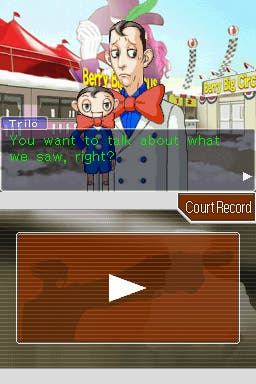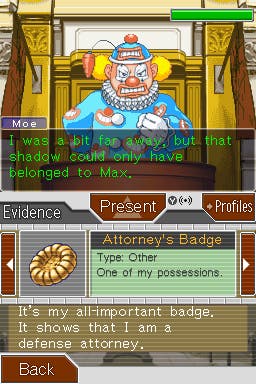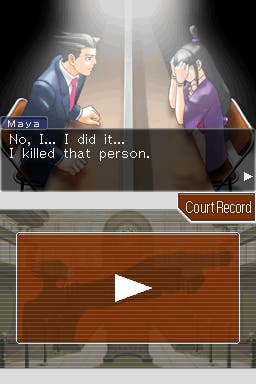Phoenix Wright Ace Attorney: Justice For All
Order! Order! Order it right now!
They're back! Oh, happy days. Phoenix and Maya, once more talking utter gibberish at each other, while solving murders most strange. Snoopy dance!
For those who are new to Phoenix Wright, perhaps the most sensible thing is to quickly hop over and read last year's review. I know that seems terribly lazy, but it's that, or a horribly repetitive follow-up. And I'm terribly lazy. But don't worry, I'll also do that clever journalisty thing of cunningly making reference, in the very next sentence.
Defence lawyer Phoenix Wright, and his spirit medium Maya Fey are back once more, taking on a new batch of murder cases in this point and click court-room drama. (There, see how I did that? This is like seeing behind the curtain, right?) What matters is that yes, it's as splendidly crazy as ever, replete with recurring characters, running jokes, and new developments in the soap story of Phoenix's relationships with the evil prosecutors.

If you remember the tutorial of the original, you'll recall the hopeless way Phoenix was 'tested' by the judge to prove he was capable of being a lawyer, by such feats as remembering the victim's name. While a ludicrous idea in a gleefully ludicrous game, it still stank of awkwardness. Never fear, Justice For All has a far better idea: Phoenix gets hit on the head right before the case, and loses his entire memory! Just long enough for Maya to have to remind him what to do. Rather nicely, this tutorial extends beyond Phoenix's bruising amnesia, and develops into a chunky chapter for the game. Certainly shorter than those that follow, it nevertheless has you play through a full court case, with a decent self-contained story.
Chapter 2 is where the game starts proper, told in flashback to explain how Maya came to be back with 'Nick, after leaving him to train as a spirit medium. Oh yes - they haven't forgotten the daftest element of the original. For those that missed out, Mia, Maya's older sister, died in the first main story of the first game, but appears throughout to save the day when psychically channelled by Maya. Previously this just sort of happened, Phoenix slightly bemused by it but just muddling through. No one else seemed to notice Maya's teenage form suddenly transforming into the huge-breasted body of Mia, and it was accepted. This time around there's no such subtlety.
The murder of Chapter 2 (don't worry - all spoilers are disguised for their own protection) takes place at Maya's spiritual camp, involving the channelling of a dead nurse by Maya for a doctor who may or may not have been complicit in the nurse's death. And then the nurse, or was it Maya, kills, or is it doesn't kill, the doctor. Confused? Not nearly as much as you'll be once you try to have a conversation with Ini Miney, valley girl loon who's staying at the camp, or Pearl, the eight-year-old daughter of Maya's aunt who is certain that Phoenix and Maya are deeply in love. So obviously it's little sane relief when psychic photographer, Lotta Hart, reappears...

And so, once more, we're back in. Constant chuckling abounds as you plough through the elaborately silly conversations, or tap on every item in each location, with Maya excitedly working out how everything might be connected to her eating a burger in the near future. The volume of awful puns this time has doubled, Phoenix generally ouching at them for you, while Maya either misses them completely or finds them impossibly hilarious. In fact, there's one pun so good (read: awful) in Chapter 2 that to even hint at it would give away the murderer! That's some punning.
The most significant new features for part two would be the Magatama and the Psyche-Locks. Remember the strange 9-shaped thing Maya wore around her neck? It's a Magatama, and this time you get one, charged with mystical energy, which can be used to break Psyche-Locks that witnesses use to withhold information. This all takes place outside of the courtroom, during the investigation sections, meaning that the Court Record-based interrogation is no longer kept indoors. A conversation option will appear with a padlock on it, only possible to open once you've gathered enough evidence to prove the witness is keeping knowledge from you. These sections, like the courtroom cross-examinations, will penalise you for making mistakes. Rather than the previous row of exclamation marks, this time you have a green bar that reduces as mistakes are made. Once it's empty, it's game over. However, when trying to open Psyche-Locks, you can replenish the bar by correct answers.
Sadly no such device is added to the cross-examinations, meaning Justice For All falls down in the very same way as the original. Occasionally the evidence you must present to a particular statement is madly obscure, forcing you to resort to guess work, which then means lots of saving and reloading and frustration. Having the meter refill by correct answers would have been splendid. Having no meter at all would have been downright sensible.

Other niggles? There are a few typos in the text, grammatical mistakes or misspelled words. Not very many, and it's hard to care when remembering that this is a Japanese release, which mysteriously offers a complete localised translation. In fact, in terms of localisation this is incredible. Despite the distinctly Eastern feel to most locations, it states that it's set in America, and then goes head-first into uniquely English-language gags. Not only the puns, but also some far more surprising moments. Chapter 3 involves the murder of a circus ringmaster, and thus a cast of the most peculiar circus performers you could dream of (the apparently borderline ventriloquist, Ben, and his puppet, Trilo Quist (yes, sorry) being of particular note). One of these is a clown, who when on the witness stand suddenly bursts into a parody of the Fresh Prince theme tune. It's on screen for literally a second, before vanishing, but it definitely said, "In West Clownadelphia born and raised..." and that a couple of clowns who were up to no good started making trouble in his neighbourhood. Madder than a bag of hatstands.
Sadly this second re-release of the Japanese-only GBA games doesn't come with a bonus fifth chapter built especially for the DS. It's still, of course, all touch-screen driven, and once more you can shout "OBJECTION!" into your mic to scare other train passengers, but with the tutorial counting as one of the four chapters, it's a far shorter game. Not a short game, by any means, but not as wildly long-lasting as the former.
But don't let that bother you. This is the most joyfully daft fun imaginable, bursting with in-jokes and hilarious set-pieces. Good old Gumshoe has a whole new stock of replies for his continued confusion when you present him with your defence attorney badge, and Maya (and indeed little Pearl) provide non-stop delight. Every location has a ton of gags to find, and then a ton more when another character is around to add in their comments. The court sequences are still maddening with their refusal to accept perfectly valid evidence for no discernable reason, and for this reason it once more fails to achieve the nine I'd so love to give it. But anyone who fell in love with the first Phoenix Wright will know how easily this is forgiven. How can you complain when the prosecutor (a certain Ms. von Karma) begins thwacking the judge across the head with her whip because she's cross? Go ahead, import it, you will not be disappointed.


